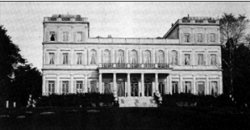Villa Günthersburg, Bornheim, Frankfurt, Germany
In 1837 Carl von Rothschild (1788-1855) acquired the Günthersburg estate situated to the north of Frankfurt and gave it to his son Mayer Carl (1820-1886).
Between 1837 and 1839, the grounds were redesigned by the Frankfurt city gardener Sebastian Rinz into an English landscape garden with large lawns and groups of trees. The original house on the estate was pulled down, and what was to become Mayer Carl’s summer house, the Villa Günthersburg was built on the estate in the 1840s, on a scale which impressed the Rothschild cousins. The architect was Friedrich Rumpf who had previously designed the property at the Bockenheimerlandstraße for Mayer Carl’s uncle Amschel von Rothschild (1773-1855). In 1855 an orangery was built on the site of the original house.
"Uncle Charles... is building a most magnificent house, large enough to hold us all. He has almost 150 acres there, the garden will be pretty", wrote Lionel in a letter to his brother Nat. His mother Hannah was more sceptical - "I have no doubt of its being a magnificent residence but at present the grounds and garden do not accord with English taste."
The Villa housed an exquisite art collection. In 1875, the magazine Deutscher Hausschatz carried an article about the collection, under the title ‘Fine Art’:
“On his villa, the Günthersburg near Bornheim, Karl v. Rothschild had a museum built in Frankfurt. It is in the side room of the large entrance hall, where bronze statues and groups from all centuries with ancient marble images of Roman emperors etc. are placed. This is followed by a rich collection of Chinese, Japanese, Persian, Saxon and Sèvres porcelain, which, apart from Dresden, is unlikely to be found anywhere else. In addition, splendid marble work from different eras joins the various living rooms and salons; in between a number of old Chinese enamel works from the imperial summer palace in Beijing; not even to think of a rich collection of porphyry vases. In two mighty ebony cabinets there is the really admirable collection of silver-blown beakers, goblets and tankards, which at the first glance shows that the human mind has always been concerned to elevate drinking to an art."
The Günthersburg Park
Mayer Carl died in 1886 without any male descendants. He bequeathed the Villa Günthersburg to the city of Frankfurt am Main. Conditions were that the park should be made accessible to the public and the Villa should be demolished in order to prevent strangers from inhabiting it.
According to the testamentary decree, the city expanded the English garden of the Rothschilds into a public city park. Two sculptures were acquired for the new park created by Andreas Weber: The Sower from Constantin Meunier at the south-western entrance to the park and The Bull from Fritz Böhle in the western part of the park. The Villa was indeed demolished, and only the orangery, which was damaged in the Second World War survives to this day. After the war damage had been repaired, it was initially used as a church by the Reformed community in 1950.
Today the Günthersburg Park covers an area of 7.4 hectares and is well used as a green space in the densely built-up Frankfurt urban area.
Return to Estates listing